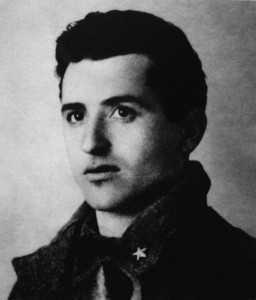“As a child he couldn’t bear to hear the shrieking of a pig under the butcher’s knife; when it was time he’d cover his ears and burrow deep under his bedcovers. Nor could he stand the smell of blood. Now blood was everywhere and it was the blood of twenty-year-old boys. He had learned to shoot, to use a bayonet…But he still couldn’t understand anything of what was happening around him. It was like being in another world or inside the nightmare of a madman.” Floti, during World War I
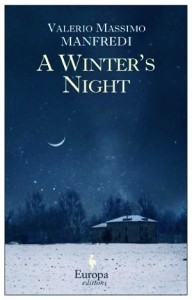 In this old-fashioned, “once-upon-a-time-in-the-old-country” saga set in northern Italy, author Valerio Massimo Manfredi introduces the Bruni family of farmers. Living in the rural hills outside of Bologna, Callisto and Clerice Bruni, parents of seven sons and two daughters, have worked the same land as generations of their ancestors, occupying the same house as their parents and grandparents, with the same large barn for their cattle. During the cold winters, the barn becomes the night-time gathering place for the family, since the warmth of their cows keeps the barn warmer than the house, and they willingly offer a warm place there to any travelers or passersby who need a place to sleep. Some of these strangers tell stories to amuse the family, some of them help with the farm work, some stay for a few days, some stay for weeks, and some, like Cleto, the umbrella mender, have been visiting so often over the years that the family now knows them well. Though the Brunis do not own the land, farming it for a landowner in exchange for half the wheat and corn crops, they feel secure and are never hungry. “In their lives, everything is always the same…one night like any other. Only nature can surprise them.” Through the stories which people bring to their door, they share the legends and mysteries of the region and add their own interpretations to events happening around them.
In this old-fashioned, “once-upon-a-time-in-the-old-country” saga set in northern Italy, author Valerio Massimo Manfredi introduces the Bruni family of farmers. Living in the rural hills outside of Bologna, Callisto and Clerice Bruni, parents of seven sons and two daughters, have worked the same land as generations of their ancestors, occupying the same house as their parents and grandparents, with the same large barn for their cattle. During the cold winters, the barn becomes the night-time gathering place for the family, since the warmth of their cows keeps the barn warmer than the house, and they willingly offer a warm place there to any travelers or passersby who need a place to sleep. Some of these strangers tell stories to amuse the family, some of them help with the farm work, some stay for a few days, some stay for weeks, and some, like Cleto, the umbrella mender, have been visiting so often over the years that the family now knows them well. Though the Brunis do not own the land, farming it for a landowner in exchange for half the wheat and corn crops, they feel secure and are never hungry. “In their lives, everything is always the same…one night like any other. Only nature can surprise them.” Through the stories which people bring to their door, they share the legends and mysteries of the region and add their own interpretations to events happening around them.
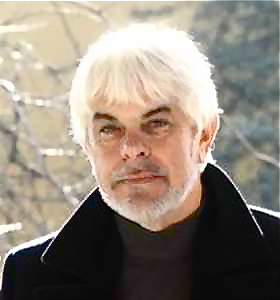
One evening in January, 1914, Iofa, a neighbor, arrives, out of breath, alarmed by something he has seen at the osteria – an old man, a stranger, with a beard so long it nearly touches his belt, with a long overcoat, and a sack over his shoulder. “[The stranger’s] eyes were as red as a demon’s,” and he has witnessed a fearsome sight – “the golden goat” in the hills in front of him, “shining in the middle of the swirling snow.” The goat’s devilish red eyes, and the old man’s sudden disappearance implies his own other-worldly origins. In the past, each sighting of the golden goat has presaged some disaster, and over the next three months, Cleto, the itinerant umbrella mender, interprets this visitation as signifying “a catastrophe the likes of which no one has ever seen.” In March Cleto leaves on his own “mission,” hiking into the hills to “find the demonic creature and destroy it or…offer [himself as] a victim in expiation.”
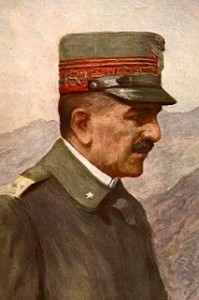
Gen. Armando Diaz
Only a few months later, World War I begins. The war changes the tone of the novel, as it does the heart of the nation, not only because of the hundreds of thousands of young men killed, wounded, or taken prisoner, but because of the totality of the horrors for every person in the country. No one can ever believe again in the simplicity of a golden goat to explain the catastrophes that have affected the entire country. All seven of the Bruni sons participate in this war, and though they all end up in different regiments, all seven are among the thousands of men lined up along the Piave River in a final attempt to prevent the Austrians from crossing. As the author tells the stories of each of the brothers and what he has seen and felt during the war, he also shows the devastation at home, with no one left to tend the fields and the cattle.
The years of Fascism form the next part of the novel’s structure, with the brothers and their friends sometimes responding differently to the rise of Mussolini and his dictatorship. Some support the need for totalitarianism as a way to control the direction of the country, others absorb the ideas of socialism, and still others believe in Marxism. The growth of unions among the farmers threatens many powerful landowners tied to the government, and the alliance of the police with the Fascists, lead to beatings, homicides, arrests, torture, and even summary executions. Conflicts among the brothers as to what constitutes their own best interests, instead of the best interest of the family as a whole, lead to divided loy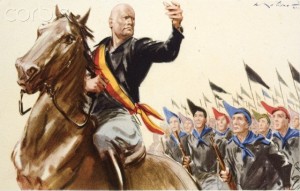 alties, and when the older generation dies off, the younger generation goes in different directions, the idea of a strong family unit destroyed by time. As the author continues their stories, these characters become paradigms of the sociological changes taking place.
alties, and when the older generation dies off, the younger generation goes in different directions, the idea of a strong family unit destroyed by time. As the author continues their stories, these characters become paradigms of the sociological changes taking place.
The final part of the novel features the next generation of Bruni sons as they deal with the many factions within Italy during World War II. Various Resistance groups fight against the Fascist Republican Army, or its extreme wing, the paramilitary Black Brigades, but the Resistenza itself is fragmented. One of the Brunis eventually confronts Mario Musolesi, known as “Lupo,” the Wolf, who commands the Red Star Resistance in the mountains near Bologna. Musolesi and his Red Star group achieve fame for their defeat of the Germans at Monte Sole, the site of the largest civilian massacre by the Germans during the war. Over seven hundred civilians, many of them women and children, some in church at the time, were massacred.
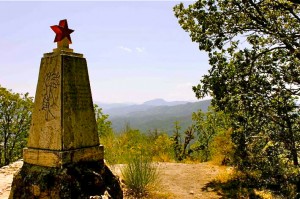
Memorial at the top of Monte Sole. It reads “Eternal glory to the partisans who on these mountains sacrificed their lives for the freedom and independence of Italy.”
This novel has something for everyone, and that is both its joy and its limitation. The scope is huge – even epic – incorporating a very large and ever growing family over several generations, as they individually deal with two world wars, the Fascism which infected Italy between the wars, and the splintering of families as their traditional way of life disappears and the sense of community yields to individual self-interest. Many characters inspire the reader’s admiration, and many scenes are variously charming, enlightening, filled with local customs and color, and exploding with the horrors of war, but for me, the novel does not jell into a coherent whole unified by powerful themes. The fact that there is not a moment of boredom in the entire novel attests to the author’s prodigious narrative abilities, but the thirty-year focus results in a novel that feels diffuse and sometimes unfocused, and the conclusion itself peters out. Though I loved parts of this book, I never gained a feeling of new understanding or new knowledge of universal truths which one associates with the great epic novels.
Photos, in order: The author’s photo is from http://www.sassuolo2000.it
General Armando Diaz, one of the primary Italian generals of World War I: http://digilander.libero.it
Benito Mussolini by Michael Nicholson is from http://www.corbisimages.com
Many images of Monte Sole, where one of the great battles of World War II took place, appear on http://ciaobologna.wordpress.com. Mario Musolesi was the Resistenza organizer in charge of the defeat of the Germans there. His group, the Red Star Resistance, is memorialized in this monument.
Musolesi’s portait is from http://it.wikipedia.org
ARC: Europa
